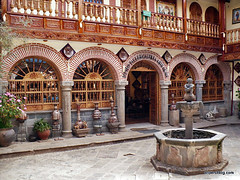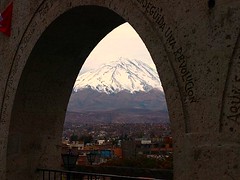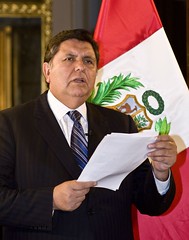Peru’s reading culture
Bill Cochran, reader, librarian, Gutenberger and Twitter user, wondered what my take on reading, library and book culture in Peru was. I personally am an avid reader. I like reading factual texts, not entire texts, but just the parts that catch my interest before I spot another theme or topic of that launches me into another book – perhaps halfway through another book. I can while away hours like this, loosing track of time – my feeble product-of-its-time miniute concentration span and my constant hopping about never allowing me to become bored. Like probably a growing number of others, I don’t read much fiction for entertainment, preferring to have my imagination done for me in the form of TV. But at least I read.
What I am getting at is that I might not be as knowledgeable in this subject as I could be, and my opinion below about Peruvians is just my opinion. It may be incorrect, perhaps I have been meeting all the wrong people. If you are Peruvian or have lived here, I would ask you to please leave your comment at the end of this post and tell us what your experience is.
Do Peruvians read? No.
If reading starts at home, and at infancy, then there seems little chance things will change.
Peruvian children’s author Maritza Valle states;
“We have forgotten recreational reading, which is the foundation of reading comprehension and mathematical reasoning. It is demonstrated that those young people to whom their parents read as children reach a higher level of intellectual development, abilities and intelligence.”
Bad news for the vast majority of Peruvian children who don’t have a single book in their home. Peru is still very much a poor country and books a very expensive commodity. The first books a rural child would often see would be at school, and these would be low-quality photocopies that hardly entice them into the world of literature. A wealthy first-world children learns to love books for their shiny pages and bright colours. They are a toy to be played with, with the help of a parent who will translate the secrets hidden in the symbols they are slowly learning to pronounce.
Peruvians in the cities, many of them poor, are born to parents who never read and were never read to. The custom of reading is just not there.
Of course, this is not to say that children grow up with stunted imaginations – story telling has always been popular, children might listen to the wild adventures of their beloved grandfather. But the act of reading, and accessing more diverse and exotic sources of information is just not there.
Wealthy Peruvian families do not fare much better. They have fallen, in recent decades, into the same traps of TV, lack of time spent with children and stresses of modern life as western families have. Children grow up watching TV. Taught to read at school, it isn’t put into practice much at all until later on when forced to by school and not enjoyed.
This lack of practice leads to the most horrendous and appalling statistics.
“Children do not understand what they read”
“Following evaluations from the Ministry of Education, tests show that only 26% read at their age level and can identify words”
Peruvian kids, when taught, are perfectly capable of pronouncing the words on a paper, whether at their age level or not, BUT when asked what they read, they do not have a clue.
“Reading level 1: 29.1% of children, who did not locate the correct information in brief text, also did not comprehend the ideas within”
“29.2 of students, who could reach level 2, that’s to say, could point out when asked if something was or wasn’t in the text they read, could not understand the meaning of words from the context of part of the text, nor the overall idea”
Just 26% of students were able to read text, understand what it meant, explain and point out ideas discussed as well as understand meanings by context. And the other 15% of kids between ages 7 and 8? Although they were able to read out the words on the paper, they had no idea what was said and could recall not one part or one idea discussed.
Where does this leave them in the adult world?
Most adults in the cities simply do not read.
The urban poor in the shanty towns have, the sub-working class, as explained, never picked up the habit, and if they had, where on earth would they find a book to read or the money to buy one? Scratching together a living, they may in fact have other more important paths to self betterment.
The working classes have also never picked up the habit. Reading is limited to “chicha” tabloids.
In middle classes households you are likely to find dusty encyclopaedias collected one by one from newspapers. Very few people read novels for recreation, often preferring, like middle classes families around the world today, to sit down in front of the TV when getting home. Where maybe in western cities, these would probably be the biggest consumers of books, not to be read recreationally, but to past the time on the journey to work – public transportation in Peru makes this difficult. Besides, like many Peruvians – from the rural poor who sit in plazas across the country, to the checkout girl taking a bus to her job, to the bank manager at lunch – they much prefer warm human company and conversation when its available to cutting themselves off from the world and getting lost in a book. And when there’s no-one else around? Even then, the next best thing is to stare into space.
The Past
Of course, for the older generations of the middle and upper classes, reading was and is far more common. Although the custom is dying out there are visible hallmarks of the glory days of Peruvian literature. Let’s briefly mention Mario Vargas Llosa.
Jorge Mario Pedro Vargas Llosa is considered by many to be Latin America’s greatest author. And he is Peruvian. Although he has sold far greater numbers of books internationally than he has in Peru, the numbers would be enough to contradict what I have written above. But the Peru that Vargas was born into was different from the one we see today. The cities like Arequipa (where he was born) and Lima were dominated by criollo middle classes of mostly Spanish descent. Poor indigenous Peruvians lived simple rural lives and had not started descending on the cities. When Vargas Llosa shot to fame in the early and mid-60s with works like La ciudad y los perros and La casa verde, Lima was a modern city on par with others in richer nations. There were no shanty towns, just a urban working class, a slightly smaller middle class, and a small group of very wealthy. These top two economic groups bought and consumed books like many would have in those days.
Libraries and bookshops
Where I am from, there are public libraries within walking distance where you can borrow books at take them home. This to say the least is not common in Peru. Ask why and a Peruvian would give it to you straight: no-one would bother to take the book back, or pay the fines. That’s if they even borrowed a book in the first place.
Libraries exist in cities. In Lima, other than the National Library, I have seen two. As far as I know you can’t take books home with you.
I’ll have to go in some time and see if there is anyone inside. To tell the truth, I know little about them. Libraries have no part in people’s daily lives here.
It seems, if you are strange enough to want to read a book, at least a recent commercial novel, your only option is to buy it.
That means, in Peru, you have two options. Buy the original, or buy the pirated version. Yes, there’s always a pirated version.
Even if you have a good job, buying a book is a hell of an expense. Books are published often in wealthier countries and sold in the currency of those wealthier countries. This alone makes them 3 to 4 times more expensive for a Peruvian than for a Frenchman, Spaniard, North American or a Brit. Add to that cost of import, and taxes (books are taxed here like any other product) and you end up paying quite a lot. That’s why you won’t find bookshops just anywhere – you’ll only see them in wealthier areas. Buying a book won’t exactly break the bank, but you’ll certainly have to cut back for the rest of the month.
So books are pirated. Lower quality and a bit of bad spelling here and there, they are otherwise true copies of the original work and a tenth of the price. You don’t even have to go far to pick one up. You’ll probably have one waved at you by a vendor at an intersection soon enough. Well, you’ll have a DVD waved at you, but you might notice he also has a couple of the latest best selling books.
Of course, things could always change for the better, perhaps one of the various reading programs the government fails to implement could turn things around. Books like the Harry Potter series have indeed turned many more young Peruvians onto reading, just as in the west.
And if you can’t afford Harry Potter, not even the pirated version, those who truly want to can provide themselves with learning material. I bought the chronicles of Garcilaso de la Vega from a small shop in the centre of Lima for only 3 soles. About $1 US. Hmm, I guess I can concentrate long enough on one entire book if I really want to.
Tags: book, education, library, national library, reading










![The Afro-Peruvian Struggle [Featured]](http://farm2.static.flickr.com/1036/554992984_766219de66_m.jpg)